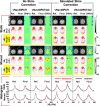Accelerated Navigator for Rapid ∆B0 Field Mapping for Real-Time Shimming and Motion Correction of Human Brain MRI
- PMID: 40905334
- PMCID: PMC12409692
- DOI: 10.1002/nbm.70126
Accelerated Navigator for Rapid ∆B0 Field Mapping for Real-Time Shimming and Motion Correction of Human Brain MRI
Abstract
∆B0 shim optimization performed at the beginning of an MR scan is unable to correct for ∆B0 field inhomogeneities caused by patient motion or hardware instability during scans. Navigator-based methods have been demonstrated previously to be effective for motion and shim correction. The purpose of this work was to accelerate volumetric navigators to allow fast acquisition of the parent navigated sequence with short real-time feedback time and high spatial resolution of the ∆B0 field mapping. A GRAPPA-accelerated 3D dual-echo EPI vNav was implemented on a 3 T Prisma MRI scanner. Testing was performed on an anthropomorphic head phantom and 11 human participants. vNav-derived ∆B0 field maps with various spatial resolutions were compared to Cartesian-encoded gold-standard 3D gradient-echo ∆B0 field mapping. ∆B0 shimming was evaluated for the scanner's spherical harmonics shims and a custom-made AC/DC RF-receive/∆B0-shim array. The performance of dual-echo and single-echo accelerated navigators was compared for tracking and updating ∆B0 field maps during motion. Real-time motion and shim corrections for 2D MRI and 3D MRSI sequences were assessed in vivo with controlled head movement. Up to 8-fold acceleration of volumetric navigators (vNavs) significantly reduced geometric distortions and signal dropouts near air-tissue interfaces and metal implants. Acceleration allowed a flexible tradeoff between spatial resolution (2.5-7.5 mm) and acquisition time (242-1302 ms). Notably, accelerated high-resolution (5 mm) vNav was faster (378 ms) than unaccelerated low-resolution (7.5 mm) vNav (700 ms) and showed better agreement with 3D-GRE ∆B0 field mapping with 5.5 Hz RMSE, 1 Hz bias, and [-10%, +10%] confidence interval. Accelerated vNavs improved 3D MRSI and 2D MRI in real-time motion and shim correction applications. Advanced shimming with spherical harmonic and shim array showed superior ΔB0 correction, especially with joint shim optimization. GRAPPA-accelerated vNavs provide fast, robust, and high-quality ∆B0 field mapping and shimming over the whole-brain. The accelerated vNavs enable rapid correction of ∆B0 field inhomogeneities and faster acquisition of the navigated parent sequence. This methodology can be used for real-time motion and shim correction to enhance data quality in various MRI applications.
Keywords: GRAPPA acceleration; magnetic resonance spectroscopic imaging (MRSI); motion correction; multi‐coil shim array; real‐time shimming; spherical harmonic shims; volumetric navigators (vNavs); ΔB₀ field mapping.
© 2025 The Author(s). NMR in Biomedicine published by John Wiley & Sons Ltd.
Figures










Similar articles
-
Map-based B0 shimming for single voxel brain spectroscopy at 7T.NMR Biomed. 2023 Dec;36(12):e5021. doi: 10.1002/nbm.5021. Epub 2023 Aug 16. NMR Biomed. 2023. PMID: 37586403 Free PMC article.
-
Impact of through-slice gradient optimization for dynamic slice-wise shimming in the cervico-thoracic spinal cord.Magn Reson Med. 2025 Sep;94(3):1090-1102. doi: 10.1002/mrm.30543. Epub 2025 May 1. Magn Reson Med. 2025. PMID: 40312894 Free PMC article.
-
Real-time measurement and correction of both B0 changes and subject motion in diffusion tensor imaging using a double volumetric navigated (DvNav) sequence.Neuroimage. 2016 Feb 1;126:60-71. doi: 10.1016/j.neuroimage.2015.11.022. Epub 2015 Nov 14. Neuroimage. 2016. PMID: 26584865 Free PMC article.
-
Motion and magnetic field inhomogeneity correction techniques for chemical exchange saturation transfer (CEST) MRI: A contemporary review.NMR Biomed. 2025 Jan;38(1):e5294. doi: 10.1002/nbm.5294. Epub 2024 Nov 12. NMR Biomed. 2025. PMID: 39532518 Review.
-
Systemic pharmacological treatments for chronic plaque psoriasis: a network meta-analysis.Cochrane Database Syst Rev. 2021 Apr 19;4(4):CD011535. doi: 10.1002/14651858.CD011535.pub4. Cochrane Database Syst Rev. 2021. Update in: Cochrane Database Syst Rev. 2022 May 23;5:CD011535. doi: 10.1002/14651858.CD011535.pub5. PMID: 33871055 Free PMC article. Updated.
References
-
- Wezel J., Boer V. O., van der Velden T. A., et al., “A Comparison of Navigators, Snap‐Shot Field Monitoring, and Probe‐Based Field Model Training for Correcting B 0‐Induced Artifacts in ‐Weighted Images at 7 T,” Magnetic Resonance in Medicine 78, no. 4 (2017): 1373–1382, 10.1002/mrm.26524. - DOI - PubMed
MeSH terms
Grants and funding
LinkOut - more resources
Full Text Sources
Medical
Miscellaneous

